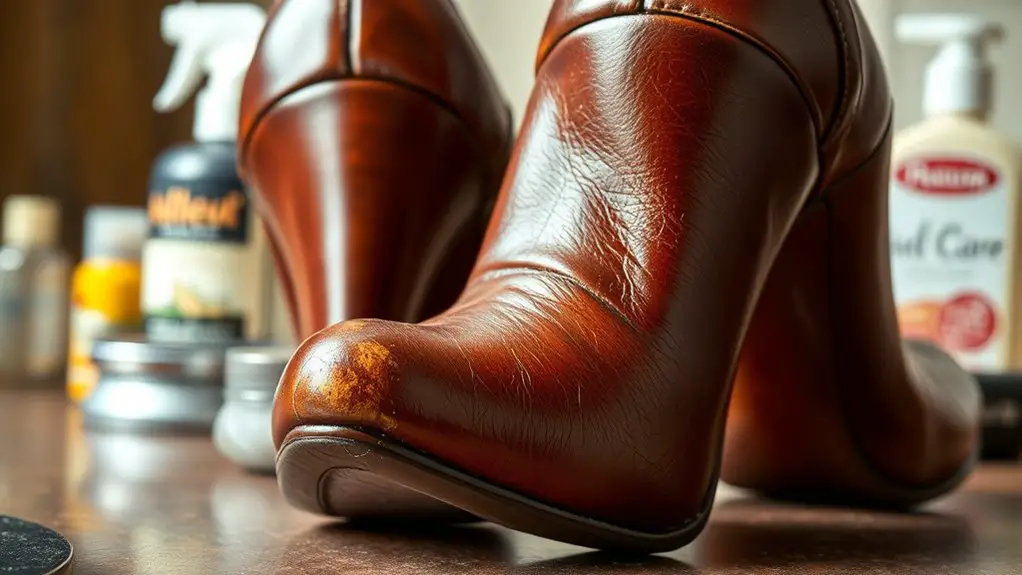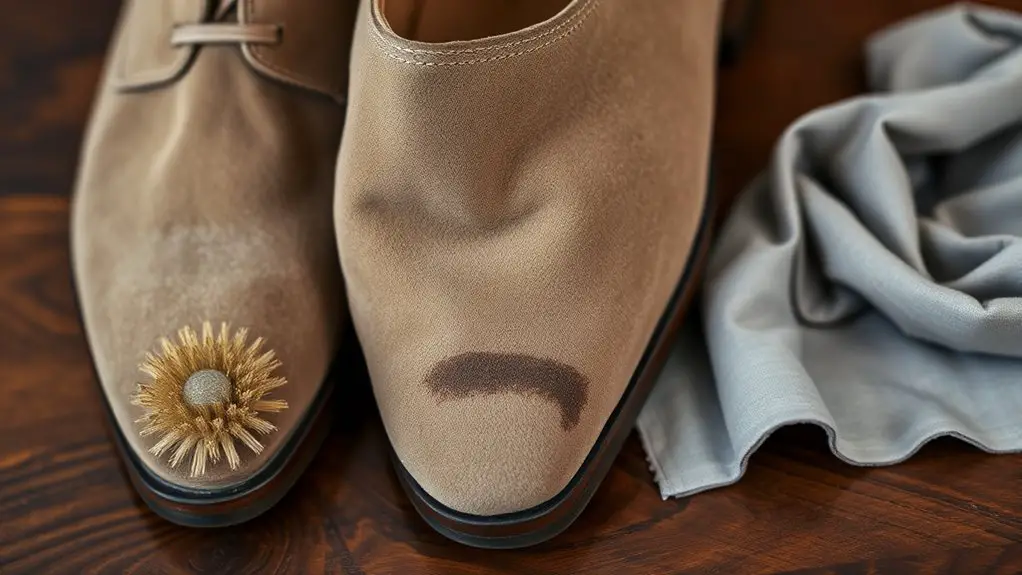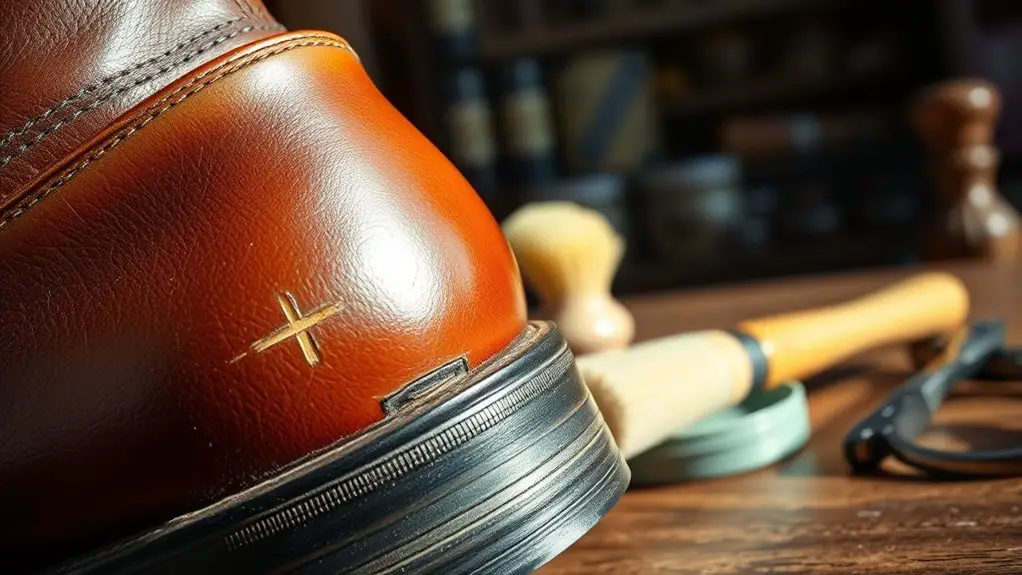To fix scratched heels and scuffed soles, start by evaluating the damage and identifying the types of scratches. Clean your shoes thoroughly using a soft cloth and mild cleaner to prepare for repair. For leather, apply conditioner and polish to conceal scratches; while for scuffed suede, use a suede brush and eraser. Restore rubber soles by scrubbing with a soap solution. Explore various DIY techniques and preventative measures to keep your shoes looking new longer. More detailed methods await.
Assessing the Damage: Identifying Scratches and Scuffs

When you notice scratches or scuffs on your heels, it’s essential to assess the damage thoroughly before attempting any repairs. Start by identifying the types of scratches present. There are generally three: surface scratches, which only affect the finish; deep scratches, which penetrate the material; and gouges, which may require more extensive repair. Next, evaluate the scuffs’ causes, which can include friction from walking, contact with rough surfaces, or improper storage.
Inspect the affected areas under good lighting to determine the extent of the damage. For minor scratches, a simple polish or conditioning treatment might suffice. However, deep scratches may require specific filler materials to restore the heel’s integrity. Understanding the type of damage and its cause is vital for selecting the appropriate repair method, ensuring that your heels regain their original appearance and functionality efficiently.
Cleaning Your Shoes: Preparing for Repair
Before you begin the repair process, gather the necessary supplies like a soft cloth, mild cleaner, and a brush. Start by removing surface dirt to guarantee a clean working area, as this will help you accurately assess the severity of the damage. Once clean, you can better determine the appropriate repair method for your scratched heels.
Gather Necessary Supplies
To effectively clean your shoes and prepare for repair, you’ll need a few essential supplies. Start with a soft-bristled brush for gentle shoe cleaning, which helps remove dirt without damaging the material. Next, gather a microfiber cloth for wiping down surfaces and ensuring no residue remains. You’ll also need a suitable cleaner—look for one specifically designed for the material of your shoes, as this will aid with scuff removal. Additionally, have a pair of cotton swabs on hand for precise cleaning in hard-to-reach areas. Finally, consider a protective spray to maintain your shoes after repairs. With these supplies ready, you’ll be set to tackle scratches and scuffs effectively.
Remove Surface Dirt
Cleaning your shoes is an important step in removing surface dirt before addressing scratches. Begin by gathering a soft brush or cloth, warm water, and mild soap. For effective shoe care, gently brush away loose dirt and debris from the exterior, focusing on seams and crevices where grime accumulates. Dampen your cloth in soapy water and wipe down the shoe’s surface, making sure you don’t saturate it. Rinse the cloth and remove any soap residue, then dry the shoes thoroughly. This surface maintenance is vital, as it prepares your shoes for further repair processes, allowing you to better assess the scratches and scuffs that need attention. A clean base guarantees a more effective and lasting repair.
Assess Damage Severity
Once you’ve cleaned your shoes, it’s time to evaluate the extent of the damage. Examining damage is essential for determining severity and deciding on appropriate repair methods. Follow these steps:
- Inspect the Scuff: Check if the scuff is superficial or has penetrated deeper into the material.
- Evaluate the Heel: Look for cracks or deep scratches that may affect the shoe’s structure and comfort.
- Check the Sole: Inspect for separation from the shoe, significant wear, or damage that may compromise traction.
Fixing Scratches on Leather Heels
Although scratches on leather heels can be frustrating, addressing them promptly can restore your footwear’s appearance and longevity. Start by cleaning the scratched area with a damp cloth to remove dirt and debris. Once dry, apply a leather conditioner to nourish the leather and help conceal minor scratches. Use a small amount, gently massaging it into the affected area.
Next, choose a matching leather polish or cream. Apply it with a soft cloth, focusing on the scratched regions. This not only helps to blend the scratch but also provides a protective layer. After the polish dries, buff the area with a clean, dry cloth for a smooth finish.
Regular leather conditioning and heel polishing will not only enhance the look of your heels but also prolong their life, preventing future scratches from becoming more pronounced. With these steps, your leather heels can look as good as new.
Repairing Scuffed Suede Shoes

Scuffed suede shoes can be restored with a few simple techniques. Proper suede care is essential to maintain their appearance and longevity. Follow these steps for effective color restoration and to eliminate scuffs:
Restore scuffed suede shoes easily with proper care techniques to enhance their appearance and extend their lifespan.
- Brush the Scuff: Use a suede brush to gently lift the fibers. This can often remove surface dirt and reduce the visibility of the scuff.
- Use a Suede Eraser: For deeper scuffs, a suede eraser can work wonders. Rub it over the affected area gently, and watch the scuff diminish.
- Apply a Suede Protector: After restoring the color, apply a suede protector spray. This helps shield your shoes from future damage and keeps the texture intact.
Restoring Rubber Soles: Tips and Tricks
To restore rubber soles, start by cleaning scuffs with a gentle soap and water solution. After ensuring they’re clean, you can repair any scratches using specialized rubber adhesive or patches. Finally, consider implementing preventive measures to avoid future damage and extend the life of your shoes.
Cleaning Scuffed Rubber Soles
Cleaning scuffed rubber soles can greatly enhance the appearance and longevity of your footwear. For effective cleaning, follow these steps to guarantee proper rubber sole maintenance:
- Prepare a Cleaning Solution: Mix warm water with a few drops of dish soap in a bowl. This gentle solution will effectively lift dirt without damaging the rubber.
- Use a Soft Brush: Dip a soft-bristled brush into the solution and gently scrub the scuffed areas. This helps remove embedded dirt and grime without scuffing the rubber further.
- Rinse and Dry: Wipe the soles with a damp cloth to remove soap residue, then let them air dry completely. Avoid direct sunlight, which can damage the rubber.
Repairing Scratched Heels
Repairing scratched heels can restore the appearance of your footwear and extend its lifespan. Start by evaluating the depth of the scratches. For minor scuffs, use a soft cloth and a suitable shoe polish that matches the color. Apply it using circular polishing techniques to blend the scratches seamlessly. For deeper scratches, consider a leather filler to fill in gaps before polishing. Once filled, sand lightly, then polish for an even finish. To protect your heels in the future, apply a protective sealant specifically designed for your shoe material. This not only enhances shine but also provides a barrier against further damage. Remember, proper heel protection can dramatically reduce the risk of scratches in the first place.
Preventing Future Damage
While repairing scratched heels enhances their appearance, taking steps to prevent future damage is equally important. Proper shoe care guarantees long-lasting protection for your footwear. Here are three effective strategies to maintain your shoes:
- Regular Cleaning: Clean your shoes frequently using appropriate materials to remove dirt and debris that can cause scratches or scuffs.
- Use Protective Sprays: Invest in high-quality protective sprays designed for your shoe material. These create a barrier against moisture and stains.
- Store Properly: Always store your shoes in a cool, dry place, using shoe trees or boxes to maintain their shape and prevent unnecessary wear.
DIY Solutions: Household Items for Shoe Repair
If you’ve discovered scratches on your shoe heels, don’t worry—simple DIY solutions using common household items can effectively restore their appearance. Start with shoe cleaning using a damp cloth to remove dirt and debris. For leather heels, you can use a mixture of olive oil and vinegar to buff out scratches; apply it with a soft cloth and polish gently. For synthetic materials, a dab of nail polish in a matching color can conceal unsightly marks. If your shoes have rubber soles, try using a magic eraser; it can effectively remove scuff marks without damaging the material. Always test these solutions on a small, inconspicuous area first to verify compatibility with the material types. Regular maintenance, including cleaning and conditioning, can also prolong your shoes’ lifespan and minimize scratches.
When to Seek Professional Help

Sometimes, despite your best DIY efforts, scratches on shoe heels may be too deep or extensive for home remedies to effectively address. Recognizing the signs that professional repairs are necessary can save you time and money. Here are a few indicators:
Recognizing when to seek professional shoe repairs can save you time and money in the long run.
- Extensive Damage: If the scratch penetrates through the material or considerably alters the shoe’s structure, it’s time to consult a professional.
- Material Type: Certain high-end materials like leather or suede require specialized techniques for repairs that DIY solutions can’t provide.
- Cost of Replacement: If the cost of replacing your shoes is close to the repair estimate, investing in professional repairs may be more worthwhile.
Understanding these signs guarantees you choose the appropriate types of repairs. When you seek professional help, you can restore your shoes effectively, prolonging their lifespan and maintaining their appearance.
Preventative Measures: Keeping Your Shoes Looking New
How can you keep your shoes looking new and prevent unsightly scratches on the heels? The key lies in proper shoe storage and preventative care. Always store your shoes in a cool, dry place away from direct sunlight. Consider using dust bags or boxes to minimize exposure to dust and scratches.
Additionally, applying protective sprays designed for your shoe material can create a barrier against dirt and moisture. Here’s a quick reference table for effective shoe care:
| Action | Frequency | Benefits |
|---|---|---|
| Clean regularly | Weekly | Reduces dirt accumulation |
| Use protective sprays | Before wear | Prevents stains and scratches |
| Store properly | Daily | Maintains shape and appearance |
| Rotate shoes | Every wear | Even wear prolongs lifespan |
| Inspect for damage | Monthly | Early detection of wear |
Frequently Asked Questions
Can I Use Nail Polish to Cover Scratches on Shoes?
You can use nail polish to cover scratches on shoes, as its benefits include color matching and quick drying. However, consider alternative remedies like leather repair kits for a more durable solution that matches your footwear.
What Materials Are Best for Repairing Synthetic Shoe Surfaces?
For synthetic shoe repair, use materials like specialized adhesive, vinyl patches, and synthetic leather. The best shoe cleaners, such as gentle foams or sprays, can help maintain the surface before and after repairs.
How Can I Prevent My Shoes From Getting Scuffed?
You’d think scuffed shoes are just a fashion statement, right? To prevent that, invest in quality shoe care products and apply protective sprays regularly. Your footwear deserves the best defense against everyday wear and tear.
Are There Specific Products for Different Shoe Materials?
Yes, there are specific products for different shoe materials. For leather care, use creams or conditioners, while fabric protection sprays work best for textiles. Always choose products designed specifically for your shoe type to guarantee ideal results.
How Often Should I Clean My Shoes to Avoid Damage?
Did you know that regular shoe maintenance can extend their lifespan by up to 200%? To avoid damage, clean your shoes every two weeks. Incorporating these shoe maintenance tips will guarantee proper cleaning frequency and protect your investment.



